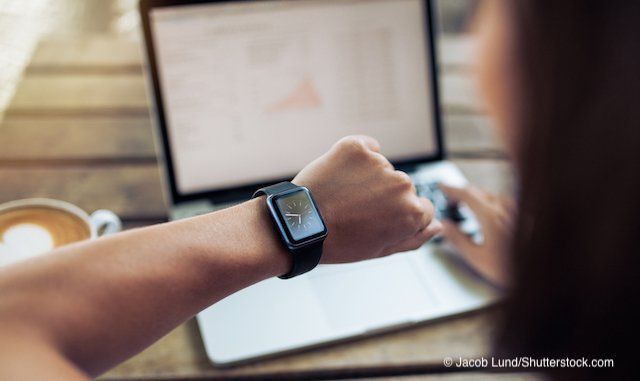Aetna, Apple Team Up on Health-Tracking App: Experts React
Aetna and Apple partner on a new wellness app that combines activity-driven incentives and rewards with personalized health recommendations. Experts share their reactions.

Hush

Sattelmair

Urbas

Hartman

Rebhan

Health insurer Aetna, a CVS Health business, and Apple are partnering on a new wellness app that combines activity-driven incentives and rewards with personalized health recommendations.
The Attain app for Apple Watch consists of customized activity goals, weekly challenges to sustain everyday health, personalized health notifications for key health moments, and reward-earning opportunities including points that can be redeemed to offset the cost of the Apple Watch or for gift cards to certain retailers.
The FDA, over the last few years, has been taking steps to encourage more development and greater innovation in digital healthcare. Personalized health wearables are evolving as Apple and Google (through Alphabet, its parent company) make their way into the space. Alphabet's Verily smartwatch recently received FDA approval for its electrocardiogram (ECG) app. In September 2018, FDA approved two ECG apps built into the new Apple Watch Series 4.
“From fitness enthusiasts, to casual gym-goers, to parents who get all their exercise by keeping up with their kids-we designed Attain for everyone,” said Alan Lotvin, MD, executive vice president of Transformation for CVS Health. “We understand that you don't need to be a personal trainer or work out several hours a day to be healthier. We’re designing Attain to be personalized and clinically relevant to where each individual is in their health journey. This is an ambitious challenge, and we will adapt and improve over time to create the best experience for our members.”
Attain is expected to be available in the Apple App Store in Spring 2019.
Related: Can Apple Act as a Go-Between Patients and Healthcare?
Here’s how experts say the partnership will affect healthcare organizations:
Theresa Hush, CEO of Roji Health Intelligence, which provides technology and consultation to healthcare systems and providers for measuring and improving patient health:
“The Apple Watch provides a prized opportunity for Aetna to obtain member fitness data and interact with these members in a new way. Many covered patients will also find it rewarding. But, there’s no silver bullet, and there will be pushback from both providers and patients. The data will raise concerns about the validity of goals developed by the insurer without patient or their provider input. Healthcare executives believe that tracking goals and improving health is their territory.
“How the data is used to reward ‘compliant’ members also carries the risk of penalizing vulnerable groups, like those who can’t meet goals because of social determinants of health. Sharing of data and analytics with providers and patients will be essential to making the program accepted and effective as it develops.”
Jacob Sattelmair, president and CEO, Wellframe, a healthcare IT company based in Boston:
“In response to the threat of disruption from new entrants, we see more and more health plans partnering with digital innovators to reimagine how they support members outside of the four walls of care delivery-what we have been referring to as ‘digital health management.’ While it will take time to determine which of these partnerships are successful in creating tangible value for members, we are encouraged that this trend will ultimately result in better member experience and higher-value healthcare.”
Jeremy Urbas, vice president of healthcare communications solutions at Broadridge, a $4-billion global fintech company:
“Aetna’s move into wearable tech is a great step toward tailoring communications for their members and reaching them via channels that are already part of their daily routines. In fact, we recently found that eight in 10 people with health insurance want more personalized experiences from their insurer. It will be interesting to see how consumers react to the sharing of data between wearables and insurers, and if this level of trust will mimic what consumers have with their doctors. Will provider networks try similar approaches? Companies could see even further digital engagement and brand loyalty in the long-term by leveraging the nuanced data in customer touch-points beyond the app, such as the bills and statements they send.”
Related: Four Health Tech Happenings Health Execs Need to Know
Cathy Hartman, SVP of customer solutions at Blue Cross Blue Shield of Massachusetts. Blue Cross Blue Shield of Massachusetts, a community-focused, tax-paying, not-for-profit health plan headquartered in Boston:
“There is still a lot of runway left for partnerships between insurers and digital health apps and wearables. The ‘quantified self’ has gone mainstream-the Apple Watch, Fitbit, health and wellness apps are used by most of the population (not just the fit and healthy)-and we are just learning about the impact they can have on raising awareness of your own biometrics, your habits and lifestyle and increasing motivation by creating continuous ‘teachable moments’ that nudge new habits and encourage engagement in health and healthcare.
“Employers & consumers are driving demand and market opportunity for these types of partnerships between payers and vendor point solutions. Employers are increasingly investing in health and wellbeing as critical part of their workforce strategy-particularly to attract and retain talent. And they are looking to health insurers/payers to reward healthy living and engagement. Consumers also expect more value from their plan and want to be rewarded for taking care of themselves.
“This Aetna/Apple program isn’t a big differentiator. While Apple is a big brand name-there are similar partnerships and programs in the market (e.g., UnitedHealthcare Motion program and our ahealthyme Rewards program in partnership with Virgin Pulse) which integrate with multiple devices including the Apple Watch. The UnitedHealthcare Motion program is singularly focused on physical activity and the requirements to earn the incentive are very challenging for the average healthy adult to achieve with strict criteria for requency, intensity, and total steps of 10,000 per day. In our program, members receive a Max Buzz device and can also sync any of the top consumer devices (Apple Watch, Fitbit etc.) and they can choose to engage across four areas of well-being:
- Building health awareness (e.g., tracking health habits, setting goals, engaging with daily health tips, etc.);
- Participating in heathy habits related to healthy eating, activity, sleep, stress management;
- Engaging social support via team challenges or invite-a-friend;
- Utilizing their preventive benefits for flu, cancer, wellness (verified via out claims data). Members design their own path and can earn up to $400 in total rewards for any combination of activities-dependent on their level and goals.
“Personalization will take new forms. As genetic testing becomes ubiquitous, this will likely become a new source of personalization. Our genetic profiles may be integrated into wearables and apps to help shape more personalized recommendations and goals related to heathy eating (e.g., what nutrients you need) and type of activity, etc.”
Andrew Rebhan, research consultant, Health Care IT Advisor Program, Advisory Board, a best practices research firm, and an Optum. Inc. business:
“Wearable programs present a host of challenges and opportunities. It’s estimated that about one-third of consumers stop using their wearables after six months. The reasons for this abandonment include forgetting to wear the device, a loss of interest, or users meeting their fitness goals. However, there are a variety of factors that can boost user engagement, such as digital coaching, support from a social network, and user-friendly features.
“Financial incentives in particular (e.g., HSA contributions, gift cards, charity donations) can help to persuade patients to alter their health habits and behavior-the question is, do these incentives provide long-term change that work across multiple patient populations (e.g., young versus old, sick versus healthy, tech-savvy versus tech-challenged)? For example, providing a ‘free’ Apple Watch that users can pay off by meeting weekly/monthly health goals is likely to draw a lot of volunteers, however once they’ve met those conditions to pay off the device, will their motivation plummet? Furthermore, how should healthcare organizations acquire, aggregate, and manage these data? How will it influence clinician work flow? Do clinicians even want all these data? Is it actionable information? Does patient-generated data open up a new source of liability?
“Despite these challenges, wearables do offer new ways to increase patient satisfaction and turn passive patients into active healthcare consumers (e.g., tracking and encouraging personalized health goals). Such devices also provide a whole new set of continuous data to give healthcare stakeholders a fuller picture of patient/population activity and health outside of care settings-hopefully resulting in cost savings and improved care quality due to more effective management of chronic disease and high-risk patient populations.”
In the Scope of Virtual Health and the Future of “Website” Manner, Per Ateev Mehrotra
August 10th 2023Briana Contreras, an editor of Managed Healthcare Executive, had the pleasure of catching up with MHE Editorial Advisory Board Member, Ateev Mehrotra, MD, MPH, who is a professor of healthcare policy at Harvard Medical School and an Associate Professor of Medicine and Hospitalist at Beth Israel Deaconess Medical Center.
Listen